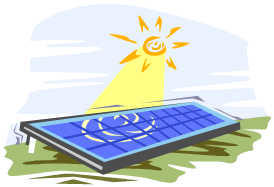Solar Power - Photovoltaic
Solar power has a number of advantages over other forms of power generation and can reasonably and cost effectively be generated at all scales – from milliwatts to power a sensor or pocket calculator all the way up to GW and larger solar farms powering whole cities on sunny days.
Whilst there are economies of scale up to a point, the cost of solar power to the end user is often attractive down to a few kW, and such economies of scale shrink with very large projects – with the very largest projects potentially incurring slightly higher per kW grid connection charges due to having to be connected to the grid at higher voltage.
For advice on solar power or any other property matters including structural surveys, building surveys, specific defect reports Free Phone 0800 298 5424.

Solar power can be generated wherever there is light though it is best used where such light is not interrupted by shade from trees, buildings etc. That being the case, solar power is suitable for installation on the majority of residential and commercial buildings as well as on structures such as car ports and in ground mounted applications.
For many businesses with adequate roof space, the right load bearing capability, and minimal shading, solar power can be an attractive option for on-site generation. This is especially so where most or all the solar power will be consumed on site.
Likewise, for residences, solar power can offer a viable return on investment even in retrofit applications, and much more so if integrated into the roof at the time of construction – where trades are already on site, construction scaffold is still in place, and solar panels form the roof surface displacing roof tiles, slates, or other more conventional roofing materials.

Technical Considerations
Suitable and Safe Access
Solar arrays should only be installed where there is safe access and sufficient space around the array for maintenance. Rooftop solar should in addition, not place an excessive mechanical load on the roof, and in the event the roof is composed of asbestos or cement fibre roofing sheets, should only be installed by experts able to ensure a compliant and safe installation. (It can be done, but it’s not a job for just anyone).

On flat roofs, ballasted no penetration installation is recommended with suitable approved installation systems so as not to void roof warranties, or introduce the risk of leakage. Given that solar panels are now a great deal less expensive than they used to be, it is also suggested to consider using pairs of panels back to back alternating between East and West facing as this reduces the cost of the mounting system, cuts the amount of ballast weight required due to less wind exposure, and allows a larger proportion of the roof to be covered in solar panels as space is not needed to keep panels from shading each other. East West installation involves a trade-off whereby more power is generated by the array due to more panels being fitted, and more of the roof area being covered, with each panel generating a bit less power due to the direction it faces not being South.
Shading
In standard string installation of solar panels, it is very disadvantageous to have even one panel in a string partly shaded such as by an adjacent wall. This is because each panel in the series can only generate as much power as the one with the lowest generation.
Suppose you have a string of 10 x 300 watt panels, with one panel part shaded - taken alone, the part shaded panel might generate 120 watts at a particular time. The remaining 9 panels are exposed to enough light to generate 250 watts each.
You would think that 2,370 watts would be generated. In practice however the other 9 panels are compromised by the part shaded panel and will only generate 120 watts each giving 1,200 watts total and just short of 50% power loss for the string!
Given the severe impact of even a little shade on a string of panels, it is suggested to either leave enough space around shade objects that shade will only occur for short periods, or take mitigating measures as described in the next section.
Free Phone 0800 298 5424
DC Optimisers and Micro-Inverters
One way to overcome shade losses is to install an electronic device on the back of each panel. This device will be either a DC optimiser of a micro-inverter. In the former case, by optimising the DC output voltage of each panel, string losses are eliminated. In the latter case, power coming off the panel is 230 volt AC (415 volts for the 3 phase version).
These devices also overcome miss-match losses where one panel is slightly less efficient, or dirty and performs less well than the rest of the string.
It is possible to buy panels where the DC optimiser / micro-inverter hardware is installed at the factory saving on purchase cost and installation time.
There is a cost to these options, and on a large install with a few panels located where shade issues can occur, these can be installed on their own separate string on their own inverter eliminating the shading issue whilst avoiding the additional cost of installing the technology on every panel.
Note:- Both DC optimisers and micro-inverters have the advantage of controlling voltage at the panel level eliminating high voltages in panel strings when the array is turned off. This brings safety advantages to fire crew if they need to access a roof during a fire by eliminating a small but real electrocution risk. (Some US jurisdictions pretty much mandate this approach as a safety measure).
Panel Efficiency
In recent years, the efficiency of solar panels has been getting higher and costs have rapidly declined. As a result, it is now possible to obtain high efficiency solar panels from major suppliers for only a few pence a watt more than lower efficiency panels from second string manufacturers.
Given the small differential in panel prices, and the fact that the cost of an installed solar array is dominated by costs such as labour, and planning, it will in nearly every case be worth spending a little more per watt on the panels as you will get it back in per watt savings on other aspects of the installed cost. You will also be getting solar panels from a top class manufacturer whose quality control processes are likely to be better.
It should be noted that whilst solar panels thrive on bright light, they do not like high temperatures, and will lose efficiency as they get hotter. High efficiency solar panels will generally have a better temperature coefficient than lower efficiency solar panels meaning that they lose less efficiency as they get hot. In addition, with higher efficiency, more light is converted to electricity and the panel consequently stays a little cooler.
As a result of the above, a high efficiency solar panel will generally produce more electricity per nominal watt than a less efficient model.
Don't compromise by installing cheap low efficiency solar panels from an unknown manufacturer as any savings will most likely disappear once the rest of the install cost is taken into account. You may also be buying problems.
Other Interesting Articles
Click on the links below for further information:
Solar - The Options
How do buildings lose and gain heat?
New House Heating System
Air Conditioning System
Heat Pumps
Ground / Water Source Heat Pump
Bifacial Panels
An increasing proportion of panels are capable of using light reflected onto the back of the panel and converting it to electricity. Where there is the possibility of this reflection taking place, it is worth using bifacial panels as their cost is only very slightly higher than standard panels, and depending on factors like mounting height and the reflectivity of the surface over which they are mounted, yield can be increased by between 5% and 30% so lowering the levelised cost of electricity.
Permissions
In the UK, roof mounted solar panels on residential rooftops generally do not require planning permission except where the array exceeds 4 kW, is significantly higher than the roofline, is on a listed building, or in a conservation area. Larger arrays such as those on commercial buildings will need planning permission which is usually dealt with by the installer, however this is usually a formality.
Where there can be greater issues for arrays larger than 4 kW is with distribution network operator (DNO – The grid operator) from whom connection permission is required – this depends on whether solar power can be connected via the local transformer without either overloading it, or risking a local grid voltage excursion outside of the allowable range.
In some cases, the DNO may set a maximum AC connection capacity which will either limit the size of the array or require special arrangements to ensure that the array can never export more than the maximum allowed amount of electricity.
Batteries
In some cases, batteries can greatly increase the proportion of self-consumption and or make savings in other ways by reducing the maximum half hour kVa demand, or by charging from off peak electricity for use during peak hours.
A business case will need to be formulated to determine if batteries can be profitable for a specific case.
Cleaning
Usually rain will be sufficient to keep solar panels reasonably clean, and the yield gain achievable by cleaning may not be warranted, however in some cases larger arrays may justify occasional cleaning. This is especially the case in dusty areas.
Pigeon Proofing
One common issue affecting many solar arrays on pitched roofs is that of pigeons nesting in the warm secluded environment provided in the space behind a solar array. This can result in considerable mess as well as damage to the solar panels, and a public health risk. It is well worth the modest additional expense of installing pigeon proof wire mesh around the array to prevent the problem before it occurs.
Routine Maintenance
Solar arrays will generally require very little maintenance, however they should be inspected and tested every 2 years by a qualified electrician with relevant experience to check the condition of cables and connectors, safety in general, and possibly give the array a clean with deionised water.
Larger systems such as solar farms may justify additional maintenance such as infrared drone inspections to check the condition of the panels and identify any hot spots – so allowing underperforming panels to be replaced.
Independent chartered surveyors
f you truly do want an independent expert opinion from a surveyor with regard to building surveys, structural surveys, structural reports, engineers reports, specific defects report, dilapidations or any other property matters please contact 0800 298 5424 for a surveyor to give you a call back.
If you have a commercial property, be it leasehold or freehold, then you may wish to look at our Dilapidations Website at www.DilapsHelp.com and for Disputes go to our Disputes Help site www.DisputesHelp.com .
1stAssociated articles
We hope you found the article of use and if you have any experiences that you feel should be added to this article that would benefit others, or you feel that some of the information that we have put is wrong, then please do not hesitate to contact us (we are only human). For more information contact us on Free Phone 0800 298 5424.
The contents of the website are for general information only and is not intended to be relied upon for specific or general decisions. Appropriate independent professional advice should be paid for before making such a decision.
All rights are reserved, the contents of the website are not to be reproduced or transmitted in any form in whole or part without the express written permission of www.1stAssociated.co.uk.


